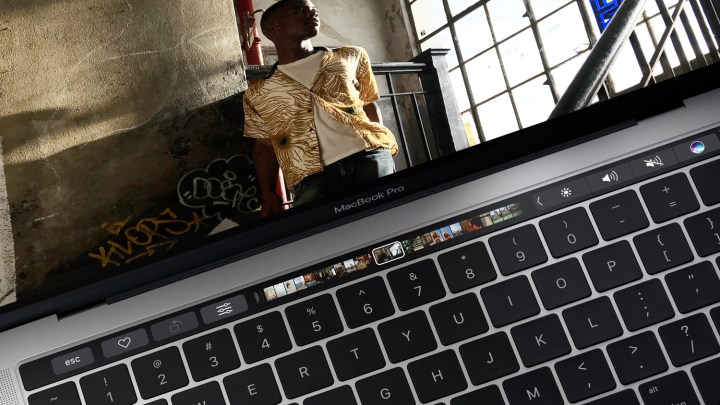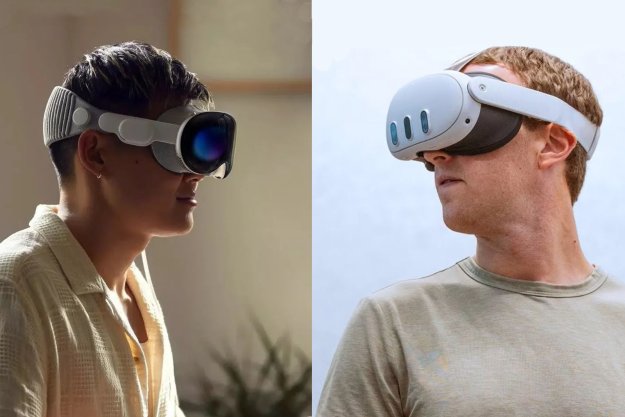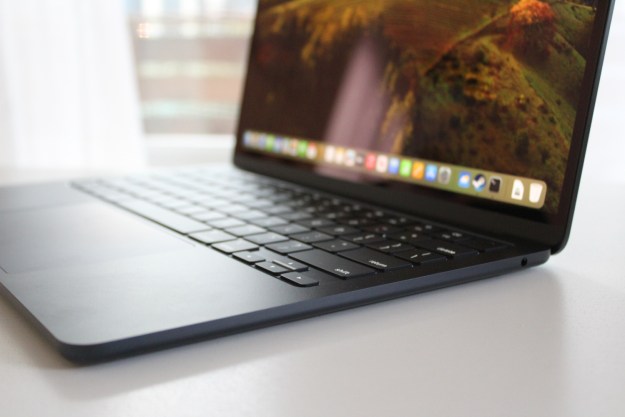
The new Pro’s headline feature is the Touch Bar, an OLED multitouch display that replaces the row of function keys at the top of the keyboard. It’s customizable, and changes based on the software you use.
But there’s a lot more to the update than that. In some ways, the MacBook Pro is more competitive than it’s been in years – yet in others, it continues to fall behind.
So about those specs
As you’d expect, Apple declared the new MacBook Pro the most advanced laptop ever made. But does that hold true?
Not really.
The new Pro’s chassis is smaller than before. The 13-inch model is now only 0.59 inches thick and weighs a hair over three pounds, while the 15-incher is 0.61 inches thick and weighs a tad above four pounds. Both models also reduce their overall footprint, thanks to thinner display bezels. That’s good news!
Some competitors already have it beat.
But some competitors already have it beat. The Dell XPS 13 and 15 are slightly lighter, and the 13-inch model is smaller overall. Dell’s options also feature a more radical metal-on-carbon-fiber design. This is to say nothing of Microsoft’s Surface Pro 4, which is kind of a different beast – and one Apple still can’t really answer (unless you count the iPad Pro, which doesn’t run a desktop OS).
What about the processor? The story isn’t much different. Apple has opted not to use Intel’s latest 7th-generation Core hardware. That’s because Intel doesn’t offer 7th-gen Core chips with Iris Graphics yet, and Apple prefers that option. Still, the timing of Apple’s update means the processors are going to look out of date come next spring, unless a mid-cycle update is slipped in.
It’s not all bad news, though. We like seeing Apple opt for AMD’s latest Polaris graphics architecture in the 15-inch model, known to gamers as the Radeon RX series. The hardware found in the Pro targets professionals, not gamers – so it probably won’t be all that fast. But its efficiency gains should keep power draw and heat output down.
Then there are the hard drives, always a highlight of Apple laptops. The company claims performance of up to 3.1 gigabytes per second, which is frankly overkill. But hey, fast is fast, and it’s fair to expect the Mac will continue to clobber most of its competitors in this arena.
The Touch Bar could be the Mac’s ‘Eureka!’ moment
The specifications weren’t the focus of Apple’s presentation, though. That honor went to the Touch Bar, and for good reason. It shows awesome potential.
Efficiency gains should keep power draw and heat output down.
Think about Apple’s best product, the iPhone. What makes the iPhone great is Apple’s control over every aspect of its design. It’s the most secure phone, because Apple controls everything about how users log in, and how it’s encrypted. The dual camera on the iPhone 7 Plus is awesome because it works seamlessly with the Camera app, so users don’t need to learn anything new to snap photos. It’s incredibly fast because it has an Apple-designed processor that outperforms everything else on the market. And so on.
Apple hasn’t enjoyed that level of control over the Mac. Yes, the Mac is Apple’s product – but many of the individual components were designed outside Cupertino. The Mac has rarely offered a feature that simply can’t be found elsewhere, in any form.
Until now.
The Touch Bar is unique. Its closest analogue may be the customizable keys found on certain early models of Razer’s Blade. But the function of those was limited, because Razer doesn’t control the software that runs on its laptops. Apple does.
It was easy to see the benefit of that in Apple’s demos, and in our hands-on time with the MacBook Pro 15. New options pop in quickly and seamlessly. Customizing the bar is a cinch. And its performance, at least in the limited time we did use it, was flawless.
This is something that a Windows laptop, no matter how good, simply isn’t going to do. Even if Dell or HP did source the hardware, it would need Microsoft to build in proper support, or risk going it alone with proprietary software that runs on top of Windows (which, if history is a guide, would be a disaster). The Dell XPS 13 may be thinner and lighter than the MacBook Pro 13, but it’s never going to have the Touch Bar.
Carrying the weight of the Apple
Still, the Mac isn’t out of the woods yet.
The Touch Bar looks great, but it’s a feature that graces just two laptops in Apple’s expanding product line. To the dismay of Mac enthusiasts, Apple spent a third of its “Hello Again” event talking about Apple TV. There was no information about a revision for the MacBook Air, the MacBook, the iMac, or the Mac Pro, the last of which is now Apple’s most neglected product.
Microsoft’s Surface Pro 4 and Surface Book are obvious points of comparison, given the new MacBook Pro’s sky-high pricing. Compared to the MacBook Pro 13, the Surface Pro 4 is clearly cheaper; the Core i5 model with 8GB RAM and a 256GB drive is going for $1,300. The Book is a bit more complex to compare, but roughly comes in at a similar price. The displays are even bigger wins for Microsoft – both have full touchscreens that are more pixel-dense than the non-touch displays found on the MacBook Pro, new or old.
In a way, the Touch Bar reflects poorly on one of Apple’s most controversial decisions – the refusal to support touchscreens with MacOS. The Touch Bar’s smooth operation makes the touchscreen more sorely missed. As our own Malarie Gokey noticed during her hands-on, she instinctively reached out from the Touch Bar to the screen several times. The Bar feels so smooth, and so natural, yet the screen itself remains a glossy, impermeable barrier between the user and MacOS. And that’s a shame.
Editors' Recommendations
- These 6 tweaks take MacBooks from great to nearly perfect
- If you buy one MacBook Air alternative, make it this one
- The case for buying the M2 MacBook Air over the M3 model
- Which color MacBook should you buy? Here’s how to pick
- Why you should buy a MacBook Air instead of a MacBook Pro


